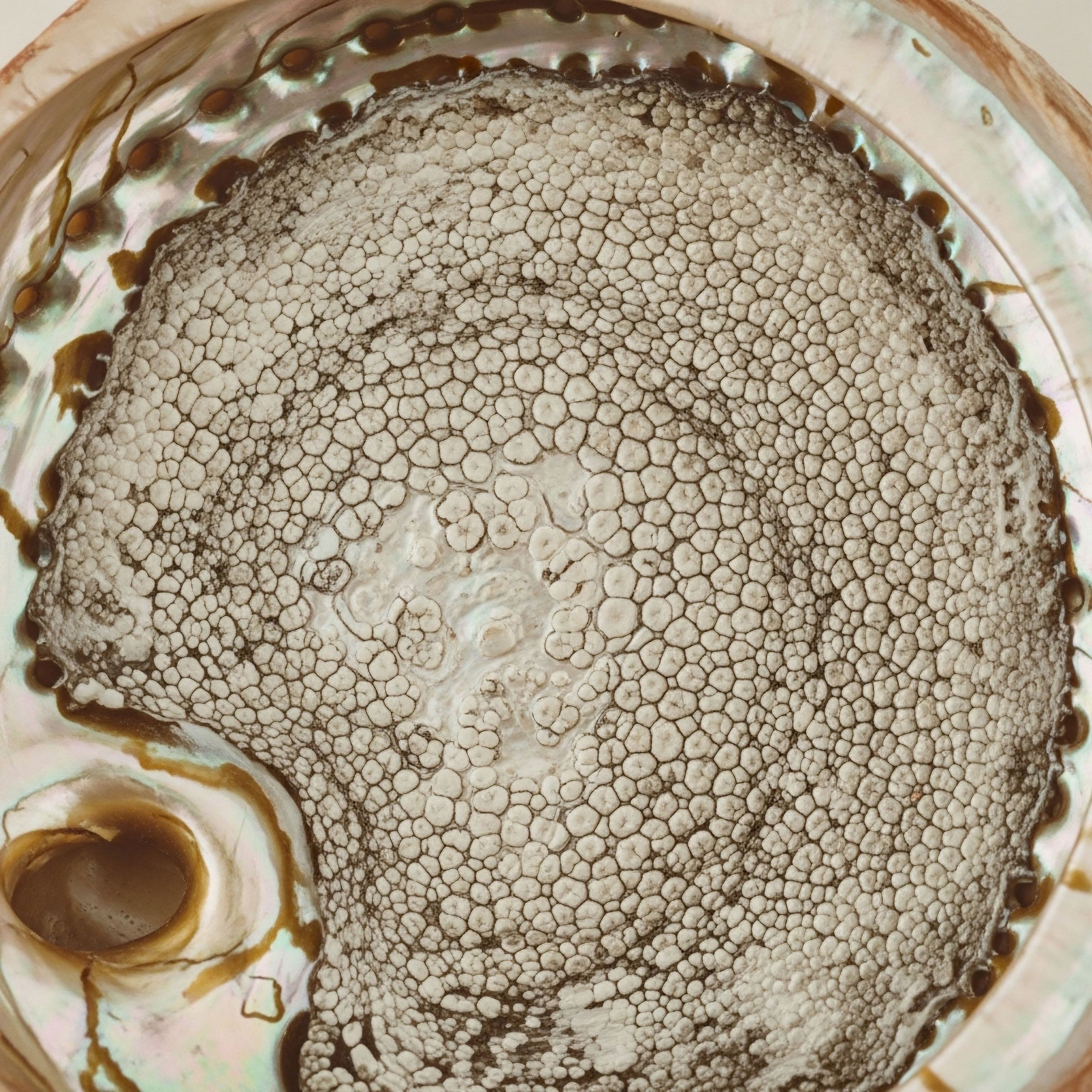

Fundamentals
Many individuals experience the profound frustration of restless nights, a sensation where the body lies still, yet the mind races, and true recuperation remains elusive. This pervasive feeling of waking unrefreshed, despite hours spent in bed, speaks to a deeper biological imbalance.
It is not merely about feeling tired; it is about a fundamental disruption in the body’s capacity for restoration. This disruption often signals an underlying disharmony within our intricate hormonal systems, particularly those governing sleep architecture and metabolic vitality. Understanding these biological systems is the first step toward reclaiming genuine rest and, with it, a renewed sense of well-being.
Sleep is a complex, active process, far from a passive state of unconsciousness. It unfolds in distinct stages, each serving a unique restorative purpose. These stages cycle throughout the night, typically comprising periods of non-rapid eye movement (NREM) sleep and rapid eye movement (REM) sleep.
NREM sleep is further divided into lighter stages and deeper stages, with the deepest being slow-wave sleep (SWS), also known as deep sleep. During SWS, brain activity slows significantly, and physiological processes shift towards repair and regeneration. This phase is critical for physical restoration, memory consolidation, and the optimal functioning of the endocrine system.
A key player in this nocturnal symphony of restoration is growth hormone (GH). This essential peptide, produced by the pituitary gland, exhibits a pulsatile release pattern, with its most significant secretory bursts occurring shortly after sleep onset, predominantly during periods of SWS. This intimate connection highlights sleep’s role as a primary regulator of GH secretion.
The body relies on these nocturnal GH surges for a multitude of vital functions, including tissue repair, muscle protein synthesis, fat metabolism, and the maintenance of bone density. When deep sleep is compromised, the natural rhythm of GH release is disturbed, potentially leading to a cascade of systemic effects that undermine overall health and vitality.
Disrupted deep sleep often indicates an imbalance in the body’s hormonal systems, particularly those linked to growth hormone secretion.

The Somatotropic Axis and Sleep Regulation
The relationship between sleep and GH is bidirectional, forming a crucial feedback loop within the hypothalamic-pituitary-somatotropic (HPS) axis. The hypothalamus, a control center in the brain, releases growth hormone-releasing hormone (GHRH), which stimulates the pituitary gland to secrete GH. Simultaneously, the hypothalamus also produces somatostatin, a hormone that inhibits GH release.
During early sleep, a surge of GHRH, coupled with a temporary reduction in somatostatin, orchestrates the significant nocturnal GH pulse. This delicate balance ensures that GH is released precisely when the body is primed for its restorative work.
As individuals age, a noticeable decline occurs in both the quantity and quality of deep sleep, paralleling a reduction in GH secretion. This age-related hyposomatotropism, or decreased GH activity, may contribute to various physiological changes, such as reduced lean body mass and alterations in body composition. The intricate interplay between sleep architecture and GH dynamics underscores why optimizing sleep is not merely about feeling rested, but about supporting fundamental biological processes that sustain health and functional capacity throughout life.

What Are Growth Hormone Secretagogues?
Given the vital role of GH in health and the age-related decline in its natural production, scientific inquiry has focused on strategies to support its release. This is where growth hormone secretagogues (GHS) enter the discussion. These compounds are designed to stimulate the body’s own pituitary gland to release more GH.
Unlike exogenous GH administration, which directly introduces GH into the system and can suppress natural production, GHS work by enhancing the body’s intrinsic mechanisms for GH release. This approach aims to restore a more physiological pulsatile pattern of GH secretion, mimicking the body’s natural rhythms.
GHS operate through various pathways, primarily by acting on receptors in the pituitary gland or hypothalamus. Some GHS mimic the action of ghrelin, a hormone produced in the stomach that stimulates GH release and plays a role in appetite regulation. Others act as GHRH analogs, directly signaling the pituitary to secrete GH.
The goal of GHS therapy is to optimize the body’s natural GH production, thereby supporting the numerous physiological processes dependent on this hormone, including the deep restorative phases of sleep.
How Do Growth Hormone Secretagogues Differ From Direct Growth Hormone Administration?


Intermediate
Understanding the foundational role of growth hormone and its intimate connection with deep sleep sets the stage for exploring specific clinical protocols. Growth hormone secretagogues represent a sophisticated approach to supporting the body’s natural endocrine function, particularly as it relates to sleep architecture and overall metabolic vitality.
These compounds are not direct replacements for GH; rather, they act as catalysts, encouraging the pituitary gland to release its own stored GH in a more physiological, pulsatile manner. This distinction is significant, as it respects the body’s intricate feedback systems.

Specific Growth Hormone Secretagogues and Their Mechanisms
Several GHS peptides are utilized in personalized wellness protocols, each with a distinct mechanism of action and clinical profile. Their influence on sleep cycles stems from their ability to enhance the natural nocturnal surge of GH, which is intrinsically linked to slow-wave sleep.
- Sermorelin ∞ This peptide is a synthetic analog of the first 29 amino acids of natural GHRH. It directly stimulates the anterior pituitary gland to release GH. Sermorelin promotes physiological GH pulses, which in turn support tissue repair, systemic regeneration, and crucially, enhance deep sleep phases. Its action is akin to sending a direct signal to the pituitary’s GH production line.
- Ipamorelin ∞ As a selective growth hormone releasing peptide (GHRP), Ipamorelin mimics the action of ghrelin, binding to the growth hormone secretagogue receptor (GHS-R). This binding stimulates GH release without significantly affecting other hormones like cortisol or prolactin, which can be a concern with some other GHRPs. Ipamorelin’s influence on sleep quality, particularly deep sleep, is well-documented, contributing to improved recovery and cognitive function.
- CJC-1295 ∞ This synthetic peptide is a GHRH analog that, when combined with Drug Affinity Complex (DAC), provides a sustained release of GHRH, leading to a prolonged elevation of GH and insulin-like growth factor-1 (IGF-1) levels. CJC-1295 without DAC acts more acutely, similar to Sermorelin. Its ability to promote consistent GH release supports the natural sleep-related GH pulses, thereby enhancing the depth and quality of sleep over time.
- MK-677 (Ibutamoren) ∞ This orally active GHS also mimics ghrelin, stimulating the release of GH and IGF-1. A key advantage of MK-677 is its oral bioavailability and sustained elevation of GH/IGF-1 levels over a 24-hour period. Studies have shown MK-677 to significantly improve sleep architecture, increasing the duration of stage 4 sleep (deep sleep) and REM sleep. This makes it a compelling option for individuals seeking to optimize their sleep for recovery and overall well-being.
Growth hormone secretagogues like Sermorelin, Ipamorelin, CJC-1295, and MK-677 work by stimulating the body’s own pituitary gland to release growth hormone, thereby enhancing deep sleep cycles.

Protocols for Optimizing Sleep with GHS
The administration of GHS is typically tailored to align with the body’s natural physiological rhythms, particularly the nocturnal GH release. For many GHS, subcutaneous injections are a common route, often administered in the evening to coincide with the onset of sleep. This timing aims to amplify the natural GH pulse that occurs during early deep sleep. Oral formulations, such as MK-677, offer convenience while still providing sustained GH elevation.
Dosages and specific protocols vary depending on the chosen peptide, individual needs, and clinical guidance. For instance, Testosterone Replacement Therapy (TRT) protocols for men often include Gonadorelin to maintain natural testosterone production and fertility, alongside Anastrozole to manage estrogen conversion. While these are distinct from GHS, they highlight the integrated approach to hormonal optimization.
Similarly, for women, low-dose testosterone and progesterone protocols are carefully calibrated to restore balance. The broader context of hormonal health always considers the interconnectedness of various endocrine pathways.
When considering GHS for sleep improvement, a comprehensive assessment of an individual’s hormonal profile and sleep architecture is essential. This includes evaluating existing sleep patterns, identifying any underlying sleep disorders, and assessing other hormonal markers that might influence sleep quality. The goal is not simply to induce sleep, but to restore the body’s natural capacity for restorative sleep, thereby supporting systemic recovery and vitality.
What Are the Clinical Considerations for Administering Growth Hormone Secretagogues?
The table below provides a comparative overview of common growth hormone secretagogues and their primary effects on sleep architecture, offering a clearer picture of their individual contributions to restorative rest.
| Growth Hormone Secretagogue | Mechanism of Action | Primary Sleep Effect | Administration Route |
|---|---|---|---|
| Sermorelin | GHRH analog, stimulates pituitary GH release | Enhances deep sleep phases | Subcutaneous injection |
| Ipamorelin | Ghrelin mimetic, selective GHS-R activation | Improves deep sleep quality, promotes recovery | Subcutaneous injection |
| CJC-1295 (with DAC) | Long-acting GHRH analog, sustained GH/IGF-1 elevation | Enhances depth and quality of sleep over time | Subcutaneous injection |
| MK-677 (Ibutamoren) | Ghrelin mimetic, oral GHS-R activation | Increases duration of stage 4 and REM sleep | Oral |


Academic
The intricate dance between the endocrine system and sleep architecture represents a frontier in understanding human vitality. While the intermediate discussion outlined the practical applications of growth hormone secretagogues, a deeper academic exploration reveals the sophisticated neuroendocrine mechanisms underpinning their influence on deep sleep cycles. This requires a systems-biology perspective, acknowledging that no single hormone or pathway operates in isolation. The body’s internal messaging services are constantly communicating, and sleep is a critical period for this biochemical recalibration.

Neuroendocrine Regulation of Sleep and Growth Hormone
The primary determinant of nocturnal GH secretion is sleep-wake homeostasis, rather than strict circadian rhythmicity. The most significant GH secretory burst occurs within minutes of the first period of slow-wave sleep (SWS) in the early part of the night.
This event is orchestrated by a surge of hypothalamic GHRH release, coinciding with a period of relative somatostatin disinhibition. The linear relationship between the amount of SWS and the concomitant GH secretion is well-established, suggesting a tightly coupled regulatory system. Pharmacological agents that reliably stimulate SWS, such as certain GHS, can therefore represent a powerful means of enhancing GH release.
The somatotropic axis, comprising the hypothalamus, pituitary gland, and target tissues, is not merely influenced by sleep; it also plays a role in regulating sleep itself. GHRH, for instance, has been shown to promote non-REM sleep. This reciprocal interaction highlights a complex feedback loop where optimal GH pulsatility supports robust SWS, and in turn, robust SWS facilitates optimal GH release.
Disruptions in this delicate balance, such as those seen with aging or certain medical conditions, can lead to a vicious cycle of impaired sleep and diminished GH activity, contributing to a decline in physiological function.

Mechanistic Insights into GHS Action on Sleep Architecture
The various GHS exert their effects on sleep through distinct, yet interconnected, pathways.
- Ghrelin Mimetics (Ipamorelin, MK-677) ∞ These compounds bind to the GHS-R1a receptor, primarily located in the hypothalamus and pituitary. Activation of this receptor stimulates GH release. Ghrelin itself is an orexigenic hormone that plays roles in sleep and memory, potentially by influencing orexin production. By mimicking ghrelin, Ipamorelin and MK-677 not only stimulate GH but may also directly influence neural circuits involved in sleep regulation, leading to more efficacious sleep and improved memory consolidation during rest. Clinical studies with MK-677 have demonstrated a significant increase in the duration of stage 4 sleep and REM sleep, particularly in younger subjects, and an increase in REM sleep in older adults. This suggests a direct modulatory effect on sleep architecture beyond simply increasing GH levels.
- GHRH Analogs (Sermorelin, CJC-1295) ∞ These peptides directly stimulate the somatotroph cells in the anterior pituitary to release GH. By augmenting the natural GHRH signal, they enhance the amplitude of the nocturnal GH pulse. This enhanced pulsatility, in turn, reinforces the physiological processes that occur during deep sleep. The sustained elevation of GH and IGF-1 levels achieved with long-acting GHRH analogs like CJC-1295 with DAC can provide a consistent physiological environment conducive to improved sleep quality and duration over time.
Growth hormone secretagogues influence sleep by enhancing the natural nocturnal surge of growth hormone, which is intrinsically linked to slow-wave sleep, through specific receptor interactions.

Interconnectedness with Metabolic Function and Overall Wellness
The influence of GHS on sleep extends beyond mere sleep duration; it deeply impacts metabolic function and overall systemic health. Deep sleep is a period of significant metabolic activity, where glucose regulation and insulin sensitivity are recalibrated. Chronic sleep deprivation or poor sleep quality is associated with impaired glucose tolerance and increased insulin resistance, contributing to metabolic dysfunction. By optimizing deep sleep, GHS can indirectly support healthier metabolic profiles.
The elevation of GH and IGF-1 levels, a direct consequence of GHS administration, contributes to various anabolic processes. These include increased lean body mass, reduced fat mass, and enhanced tissue repair. These physiological benefits are particularly pronounced during the restorative phases of sleep.
For instance, muscle protein synthesis and satellite cell activation, critical for muscle recovery and growth, are amplified during periods of elevated GH and deep sleep. This synergistic relationship underscores why optimizing sleep through GHS can be a powerful component of a comprehensive wellness protocol, particularly for active adults and athletes seeking anti-aging benefits, improved body composition, and enhanced recovery.
While GHS are generally well-tolerated, clinical oversight is paramount. Some studies have noted concerns regarding potential increases in blood glucose due to decreases in insulin sensitivity, particularly with certain GHS like MK-677. Therefore, regular monitoring of metabolic markers, alongside hormonal levels, is a critical component of any personalized wellness protocol involving GHS. The aim is to achieve a balanced physiological state that supports vitality without compromising other aspects of metabolic health.
How Do Growth Hormone Secretagogues Affect Metabolic Health Beyond Sleep?
The table below provides a summary of the physiological effects of optimal deep sleep, highlighting the systemic benefits that GHS aim to support by enhancing sleep architecture.
| Physiological System | Benefits of Optimal Deep Sleep |
|---|---|
| Endocrine System | Maximal growth hormone secretion, balanced cortisol rhythms, optimized hormonal feedback loops. |
| Metabolic Function | Improved insulin sensitivity, enhanced glucose regulation, efficient fat metabolism. |
| Musculoskeletal System | Accelerated muscle repair and protein synthesis, increased bone density, reduced inflammation. |
| Neurological Function | Memory consolidation, cognitive restoration, improved mood regulation, reduced brain fog. |
| Immune System | Strengthened immune response, enhanced cellular repair and detoxification processes. |

References
- Van Cauter, E, Plat, L, & Copinschi, G. Interrelations Between Sleep and the Somatotropic Axis. Trends in Endocrinology & Metabolism, 2000.
- Sigalos, JT, & Pastuszak, AW. The Safety and Efficacy of Growth Hormone Secretagogues. Sexual Medicine Reviews, 2019.
- Van Cauter, E, Plat, L, & Copinschi, G. Interrelations between sleep and the somatotropic axis. PubMed, 2000.
- Merriam, GR, & Merriam, GR. Releasing hormone and GH secretagogues in normal aging ∞ Fountain of Youth or Pool of Tantalus? Clinical Interventions in Aging, 2008.
- Swolverine. The Best Peptides for Recovery ∞ BPC-157, TB500, MK-677, Ipamorelin, CJC-1295, and More. Swolverine, 2025.
- Kenton Bruice, MD. Best Peptides for Sleep ∞ What to Know Before You Try Them. Kenton Bruice, MD, 2025.
- Peptide Sciences. Ipamorelin Sleep Research. Peptide Sciences.
- MK-677 For Beginners ∞ What You Need To Know About Growth, Recovery, and Sleep. 2025.
- PEPTIDE THERAPY.

Reflection
The insights shared here regarding growth hormone secretagogues and their influence on deep sleep cycles represent more than just scientific data; they offer a lens through which to view your own biological systems. The experience of sleep, often taken for granted, is a profound indicator of systemic balance.
When you find yourself struggling with restorative rest, it is a signal from your body, inviting a deeper inquiry into its intricate workings. This understanding is not merely academic; it is a call to action, a recognition that optimizing your physiology is within your grasp.
Consider this exploration a starting point, a foundation for a personalized journey toward enhanced vitality. Each individual’s biological blueprint is unique, and what supports one person’s hormonal equilibrium may differ for another. The path to reclaiming robust sleep and metabolic function often requires a tailored approach, guided by a deep appreciation for your body’s specific needs.
The knowledge presented here empowers you to ask more precise questions, to seek guidance that aligns with a systems-based perspective, and ultimately, to become a more informed participant in your own health trajectory.
The journey toward optimal well-being is a continuous process of learning and adaptation. As you consider the profound connection between hormonal health and the quality of your sleep, reflect on how these biological principles might apply to your own lived experience. The potential for reclaiming genuine rest and, with it, a renewed sense of energy and clarity, is a powerful motivator for engaging with your health on a deeper level.



